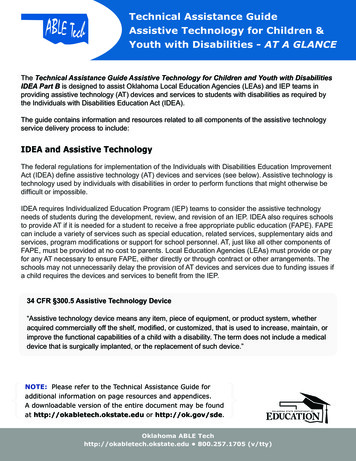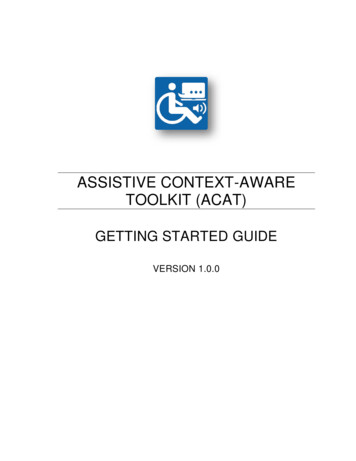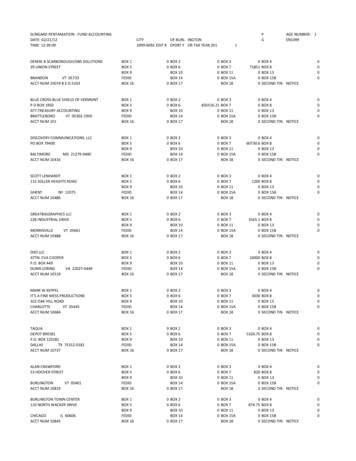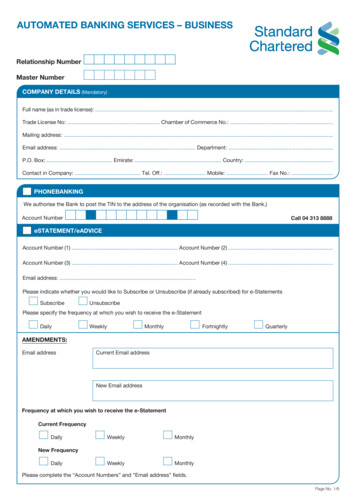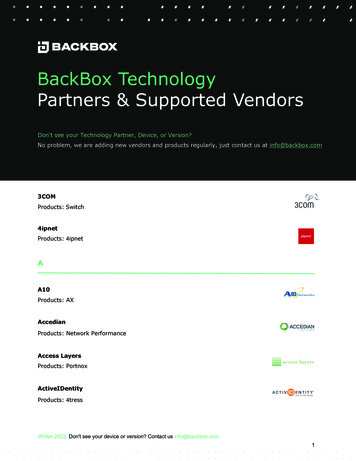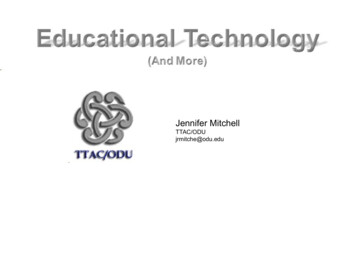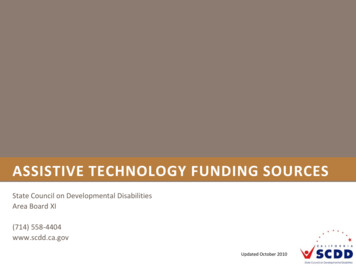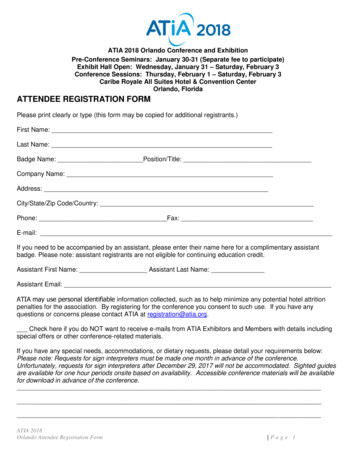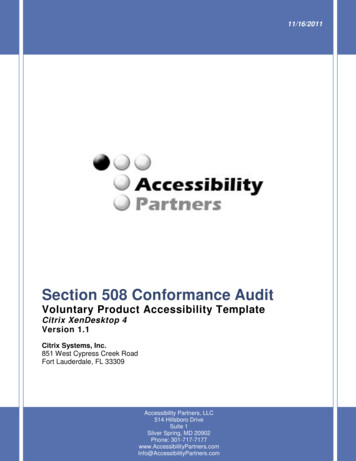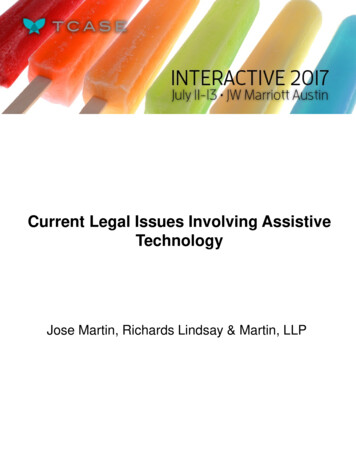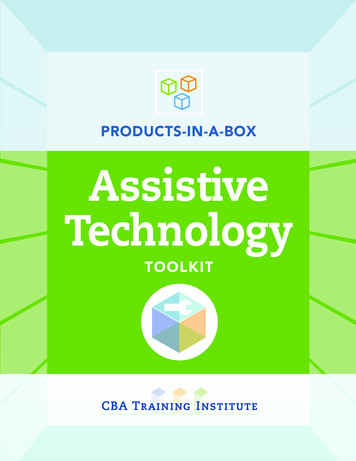
Transcription
PRODUCTS-IN-A-BOXAssistiveTechnologyTOOLKIT
1701 K Street NWSuite 1000Washington, DC 20006(202) 730-9390info@creditbuildersalliance.org2ASSISTIVE TECHNOLOGY TOOLKIT
ContentsAcknowledgmentsAbout Credit Builders AllianceForeword567Part 1:A.B.C.D.Introduction to this ToolkitWhat Is This Toolkit and Is It Right for Me?How Was This Toolkit Created?How Should I Use This Toolkit?Why Offer Assistive Technology Loans?i. Assistive Technology Cheat Sheetii. Setting up an AT Loan Program in 10 Steps888991113Part 2:A.B.C.D.Small Dollar Consumer Loans in ContextSmall Dollar Consumer Loans and Nonprofit LendersCredit As an Asset: Achieving Credit StrengthFinancial CapabilityProfile of a Nonprofit Lender: Northwest Access Fund1415161820Part 3:A.B.C.D.Initial Planning and Building the InfrastructureUnderstanding the Target PopulationBuild Strong PartnershipsRaise Funds and Loan CapitalBuild Organizational Capacityi. Staff Capacityii. Leadership Capacityiii. Board Capacityiv. Loan Oversight CommitteesE. Invest in Technologyi. Loan Softwareii. Other TechnologyPart g the LoanFederal and State Lending RegulationsPolicies and ProceduresLoan UseUnderwriting and EligibilityLoan AmountLoan TermsFees and InterestProtecting Your Loan Fund414243454651545560Part 5: Loan ImplementationA. Outreach, Marketing, and Customer AcquisitionB. ApplicationC. Loan Determination and ClosingD. Servicing and Supporting RepaymentE. Troubled Loan ManagementF. Repayment and GraduationG. Outcome TrackingPART 16363626469757979INTRODUCTION TO THIS TOOLKIT3
Part 6: AppendicesAppendix A: Financial Capability Resourcesand Outcome Tracking ToolsOutcome MatrixCredit Strength FrameworkBest Practices for Tracking Credit ScoresCredit Strength RoadmapBudget Worksheet (Federal Trade Commission)Bill Calendar (Consumer Financial Protection Bureau)Net-worth WorksheetFinancial Wellbeing Scale(Consumer Financial Protection Bureau)4858788909395104106107108Appendix B: Small Dollar Lending ResourcesAlternative Ways to Facilitate Access toLoan Funds & ProductsFederal Legislation That Impacts Small Dollar LoansConsumer Installment Loan Regulations By StateChoosing and Using Software for CBA Reporters109Appendix C: Sample Loan DocumentsSample Policies and Procedures (Northwest Access Fund)Sample Credit Reporting PolicySample Loan Outreach Materials (Self Help Credit Union)Sample Loan Application (Innovative Changes)Sample Approval Letter (Northwest Access Fund)Sample Denial Letter (Innovative Changes)Sample Credit Score Disclosure Notice(Federal Trade Commission)Sample Loan Agreement (Innovative Changes)Sample Automatic Clearing House (ACH) Form(Northwest Access Fund)Sample Customer Feedback SurveySample Customer Feedback Survey(Northwest Access Fund)Sample Late Payment Notice (Innovative Changes)Sample Adverse Action Letter (Cornell Law School)Sample Loan Payoff Letter (Northwest Access Fund)124125144149150154155Appendix D: Assistive Technology Related ResourcesExamples of People-First Language(National Disability Institute)Creating an Inclusive Environment for Your FinancialEducation Program (National Disability Institute)Setting Up an ABLE Account(Consumer Financial Protection Bureau)Paying for Assistive Technology Worksheet(Consumer Financial Protection Bureau)171Appendix E: Additional ResourcesGeneral Financial Capability ResourcesCredit Builders Alliance Training Institute ServicesGlossary of Credit and Lending Terms185186188195ASSISTIVE TECHNOLOGY 78181
AcknowledgmentsThis toolkit was developed with generous funding from the MetLife Foundation. The toolkitwould not have been possible without the learnings and insights of practitioners andother stakeholders committed to improving the lives of individuals in their communities.CBA would particularly like to thank its members who participated in interviews abouttheir programs and gave feedback on this toolkit throughout its development. Theseorganizations include:Asian-American Homeownership Counseling, Inc.Capital Good FundChehalis Tribal Loan FundThe Center for Financial Independence and Innovation Freedom First Credit UnionThe Fountain FundHousing Works Central OregonInnovative ChangesJustine PETERSONThe Lansing Office of Financial EmpowermentLatino Economic Development CenterOklahoma Assistive Technology Foundation Pennsylvania Assistive Technology FoundationMercy Corps NorthwestNorthwest Access FundThis toolkit was developed with input from the Center for Financial Services Innovation(CFSI), leveraging the organization's insights and research on the small-dollar creditmarketplace and consumer financial health.In addition, several leaders served as master reviewers of this toolkit. CBA would like toespecially thank Diana Avellaneda, Jack Baker, Pablo DeFilippi, Milissa Gofourth, CassieRussell, Nicole Snyder, Joshua Sledge, and Sabrina Terry for their input as master reviewers.PART 1INTRODUCTION TO THIS TOOLKIT5
About Credit Builders AllianceCredit Builders Alliance (CBA) serves as a unique and vital bridge between our memberorganizations and the major credit reporting agencies (CRAs). Through this support,CBA helps people and small businesses who are outside the financial mainstream buildcredit to achieve their goals and enjoy financial security. Our core services, CBA Reporter andCBA Access, provide mission-driven organizations with both the ability and critical technicalassistance to report loan data to the CRAs and to pull low-cost client credit reports for thepurposes of financial education, outcome tracking and underwriting. For more on CBA,go to www.creditbuildersalliance.org and follow us on Twitter at @Credit is Asset.6ASSISTIVE TECHNOLOGY TOOLKIT
Foreword“Credit as an asset.” I first heard this idea years ago being espoused by Credit BuildersAlliance. It resonated with me then and continues to ring true to me now. Having access to thecredit system can strengthen a person’s ability to manage their day-to-day finances, weatherfinancial shocks, and pursue opportunities to live the lives they want.Unfortunately, far too many American households lack the asset of credit access. The Center forFinancial Services Innovation (CFSI) estimates that there are over 120 million credit-challengedadults in the U.S.1 Whether due to a subprime credit score or a credit history that is insufficientto generate any score at all, these individuals are often unable to access traditional forms ofcredit offered by mainstream lenders like banks or credit unions. Not having credit limits optionsto meet life’s challenges and, with nearly half of American households being unable to cover a 400 unexpected expense,2 many credit-challenged consumers have few places to turn. For manyfamilies, having access to credit can be critical when facing pressing needs such as a higher-thanexpected property tax bill or the need for assistive technology to manage a disability.Where can people turn to meet their needs when traditional credit isn’t an option? Unfortunately,the alternatives can be high-cost, low-quality loans often made without considering theborrower’s ability to repay. Such products can make a bad situation worse when borrowers becometrapped in a debt cycle or find themselves unable to pay down a loan. Navigating the marketplaceto find the “right” option can be a tough task made all the more difficult when consumers arefacing the stress and urgency of critical financial challenges. What’s more, the market for loans isonly increasing in its complexity as online lenders of varying quality continue to emerge.Within this context, responsible community lenders can be a lifeline, offering consumers anoption not only to solve their immediate financial needs but to build their credit and improvetheir financial health. But designing a loan, attracting borrowers, and managing a loan portfolio tobalance borrower and lender success is no small feat. It is hard to get the details right to create asustainable solution that can effectively serve credit-challenged consumers.Fortunately, community lenders can succeed by learning from one another. Collectively, suchorganizations have tried a myriad of strategies for building loan programs and, naturally, somehave had more success than others. Sharing experiences can help to uncover best practices anddevelop models that work.The stakes are high as credit-challenged consumers struggle to find options to solve theirfinancial challenges and achieve financial health. Community lenders have an opportunity tomeet this challenge head-on by working together to give consumers a pathway to responsibleloans today and the asset of “credit” in the future.Joshua Sledge, Director, CFSI1Center for Financial Services and Innovation (2016, December). “2016 Financially Underserved Market Size Study,”2Federal Reserve. (2017, May). “Report on the Economic Well-Being of U.S. Households in 2016.”PART 1INTRODUCTION TO THIS TOOLKIT7
Part 1: Introduction to this ToolkitA. What Is This Toolkit and Is It Right for Me?If you are interested in offering small dollar consumer loans to specific populations in yourcommunity, or partnering with a lender who can provide these loans, this toolkit is for you!This toolkit is specifically made for organizations that are:Already lending and considering or planning to add to their loan portfolio;Not yet lending but providing population-specific services and interested in providing loansas a complimentary support for that population; orProviding population-specific services or funding and want to partner with a lender to createa loan product that meets the needs of the population that they serve.In the following sections of this toolkit, we will guide you through the steps of creating andoffering small dollar loans that meet the needs of specific populations. Part 2 discusses the fieldof small dollar consumer lending and financial capability. Part 3 provides ideas and guidance forthe initial planning for and infrastructure needs of a loan program. In Part 4, we detail the differentelements of loan design and managing a loan portfolio. Part 5 walks through the steps of loanimplementation from marketing the loan to borrower repayment and graduation. Lastly, theappendices provide sample loan documents and additional ideas and resources for small dollarlenders that aim to meet the needs of a specific target population.For organizations setting up a loan program for the first time, we hope that this toolkit enablesyou to learn from others in the field and minimize roadblocks that you will inevitably face alongthe way. For lenders who are experienced with the fundamentals of providing loans, we urge youto pick and choose sections that may help enhance your current knowledge base.B. How Was This Toolkit Created?CBA partnered with the Center for Financial Services Innovation (CFSI) to create this toolkitthrough a variety of methods:1) CBA surveyed its members in the field who offer small dollar loans to collect information onspecific loan design features and processes.2) CBA conducted follow-up interviews to gather more in-depth qualitative data about theorganizational experience of offering specific small dollar loans.3) CFSI and CBA gathered data from first and second-hand sources on examples of bestpractices in small dollar lending and population-specific loans.CBA synthesized the survey, interview, and best practices data by vetting it through focus groupswith on-the-ground practitioners and other stakeholders.8ASSISTIVE TECHNOLOGY TOOLKIT
C. How Should I Use This Toolkit?While this toolkit is full of recommendations, ideas, examples, and key considerations forproviding small dollar loans, CBA recognizes that there is no one-size-fits-all product orimplementation strategy. Your organization and partners will be responsible for customizingthe loan to meet the needs of your specific community. We encourage you to use whateverpiece(s) of the toolkit feel relevant and useful to you.Additionally, as policies, regulations, and other contexts change (at local and national levels),and innovations in lending emerge, the information in the toolkit may change as well.We urge you to consider this a living toolkit that can evolve over time. To that end, wewould love to know more about how you are integrating the toolkit into your work as wellas if there are parts that could be improved or updated. Please share your feedback bycontacting us at programs@creditbuildersalliance.org.Lastly, this information is not intended to be legal advice and may not be used as legal advice.Legal advice must be tailored to the specific circumstances of each situation. Every effort hasbeen made to ensure this information is up-to-date. It is not intended to be a full and exhaustiveexplanation of the law in any area, nor should it be used to replace the advice of your ownlegal counsel.D. Why Offer Assistive Technology Loans?A decade ago, who would have imagined that prosthetics could be produced by 3D printers3or that voice recognition software would be at the fingertips of almost every smart phoneuser? Assistive technology (AT)—“any item, piece of equipment, software program, or productsystem that is used to increase, maintain, or improve the functional capabilities of persons withdisabilities,”4—exists to help individuals adapt and successfully function within their surroundings.There is a widespread need for AT. One out of every five adults in the United States lives with adisability.5 The Center for Disease Control and Prevention (CDC) found that mobility limitationsare the most common type of disability, followed by difficulties with cognition, independent living,vision and self-care.6 For 33 out of the 53 million people living with disabilities, their disabilitymakes it difficult to carry out daily activities at home, school, in their community and/or at work.7These hardships contribute to lower earnings and higher rates of poverty, yet AT can help reducethose barriers and increase the capabilities of those living with disabilities.3Birrell, Ian. (2017, February, 19). "3d-printed prosthetic limbs: the next revolution in medicine." Retrieved from /3d-printed prostheticlimbs-revolution-in-medicine4Assistive Technology Industry Association. "What is AT?" Retrieved from ers for Disease Control and Prevention. (2015, July 30). "53 million adults in the US live with a disability." Retrieved from isability.html.6Eunice Kennedy Shriver National Institute of Child Health and Human Development. How many people use assistive devices? Retrievedfrom conditioninfo/Pages/people.aspx7ibid.PART 1INTRODUCTION TO THIS TOOLKIT9
While AT is a rapidly advancing field,8 the expense of updating one’s home, or purchasingoften costly equipment, can be prohibitive for those who need it. School systems, governmentprograms, private health insurance, job training initiatives, and employers are a first place forindividuals to seek funding for their AT needs. When these funding sources are unavailable (i.e.hearing aids are not covered by Medicare) or inadequate, assistive technology loans can bridgethe funding gap.AT loans are frequently offered by nonprofit and community development organizations.Operating under the Assistive Technology Act (ATA), which supports state and territory effortsto “assist individuals with disabilities of all ages with their assistive technology needs”9 there areabout 37 different ATA associated loan programs (ATAPs) within the US and US territories.10 CreditBuilders Alliance (CBA) has at least eight members that provide AT loans as part of their primarymissions. For example, the Northwest Access Fund (NWAF), a CBA member, nonprofit lender,and technical assistance lead for ATAP loan programs, has lent over 3 million in loan funds topeople with disabilities in Washington and Oregon. While there are a variety of AT lenders acrossthe nation to look to for best practices (a handful of which are highlighted in this toolkit), there isstill an unmet need for safe and affordable means of accessing AT. This toolkit can help guide yourorganization in taking steps to meet this unmet need through the provision of AT loans.WHAT IS THE ASSISTIVE TECHNOLOGY ACT?The Assistive Technology Act (ATA) of 1998 supports state and territory effortsto “assist individuals with disabilities of all ages with their assistive technologyneeds” through device reutilization programs, device loan programs, devicedemonstrations, and alternative financing (lending) programs. These programsare often referred to as Assistive Technology Act Programs (ATAPs).Find your state’s ATAP here.108Meshcheryakova, Tatyana. (2017, January 23). Assistive Tech Expected to Grow Rapidly. Retrieved from https://www.atia.org/atresources/what-is-at/9Civic Impulse. (2018). H.R. 4278 —108th Congress: Assistive Technology Act of 2004. Retrieved from 0National Public Website on Assistive Technology. "Alternative Financing Programs." Retrieved from inancingPrograms2015.phpASSISTIVE TECHNOLOGY TOOLKIT
Assistive Technology (AT) Loan Cheat SheetCBA Member PracticesPurposeLoans for assistive technology (AT) in order to helpindividuals with disabilities succeed in employment,education, small business development, and in theirpersonal lives and communityRestrictions on useof fundsFew restrictions. Ensure that the AT is high qualityand appropriate for the individual.Loan amount range 1,500 to 60,000* (average 3,697)(no cap necessary; see considerations)Loan terms6 to 24 for smaller loansUp to 96 months for larger loansInterest rate0%-8% (average 4.5%)Application Fee 0- 15Origination Fee 0Late Fee 0- 10Non-sufficientfunds fee 0- 25Charge-off rate2%-6% (average 3%)Loan loss reserve4%-50% (average 19%)Key UnderwritingConsiderationsAbility to paySome attention to borrower’s credit score, history,and debt-to-income ratio; distinguish betweenconsumer debt and medical debtProof that borrower has undertaken precautions toensure that the AT will effectively meet their needsPART 1INTRODUCTION TO THIS TOOLKIT11
Assistive Technology (AT) Loan Cheat SheetcontinuedCBA Member PracticesSecurity/CollateralMay take collateral on vehicle or home modificationsConsider a co-signer or security holdback to securesmaller loansLoan servicing andpaymentsMonthly payment remindersCollection proceduresNotices at 10, 30, 60, and 90 days lateFlexible payment options (online, in-person, via mail)Options for loan modificationsContact references to ensure borrower is not sickor hospitalizedSend to collections/charge-off at 120 daysBorrower support/Financial educationReview budget and credit report during theapplication processOffer ongoing financial development opportunitiesthroughout the course of the loanOffer a graduation product once loan has been paid-offCredit ReportingReport to all three credit bureausMeasuring successCollect information on:Financial wellbeingCredit strengthAsset buildingSuccess with repaymentAT’s impact on quality of lifeBorrower’s program satisfaction12ASSISTIVE TECHNOLOGY TOOLKIT
Setting up anAssistive Technology Loan Programin 10 Steps1 Understand the needs of your target populationa. What are the unique needs of people with disabilities?i. How do people who identify with disabilities describetheir relationship with mainstream financial institutionsand/or fringe lenders?Where toread more!Part 3:Understand thetarget population(pages 23-26)b. What factors should your program keep in mind as we specificallydesign the loan to meet this diverse population’s needs?2 Develop strong partnershipsa. What financial capability, social and financial services exist in yourcommunity that can compliment a loan program?i. Who can you refer clients to for additional supports?Part 3:Build StrongPartnerships(pages 26-29)ii. What organizations can help refer good candidates for loans?iii. What organizations or services may be able to offsetsome of the borrowers costs to minimize loan needs?b. What systems do I need to understand to ensure the loan productdoesn’t create unintended consequences?3 Build organizational capacity at all levelsa. Do staff have enough time and skills (population specific andlending specific) to offer loans?b. What expertise and involvement is needed from the board ororganizational leadership?Part 3:Build OrganizationalCapacity(pages 32-38)c. Will you develop a loan oversight body/loan review committee?4 Invest in technology that will allow you to growa. What loan management software will you use?b. How else can you leverage technology to meet the needs ofborrowers? committee?5 Learn about state and federal regulationsa. See Appendix B to find your local regulating body and anoverview of federal legislation that impacts small dollar lenders.PART 1Part 3:Invest in Technology(pages 38-40)Part 4:Federal and StateLending Regulations(pages 42-43)INTRODUCTION TO THIS TOOLKIT13
Setting up an Assistive TechnologyLoan Program in 10 Steps continuedWhere toread more!6 Create policies and proceduresPart 4:Policies andProcedures(pages 43-44)a. How will you ensure that your policies and procedures are fairand transparent, but flexible enough to meet the needs of yourborrowers?b. How will you revise and update your policies and procedures asyour organization gains experience in providing AT loans?c. See Appendix C for a sample of one organization’s policy andprocedures7 Determine allowable loan usesa. Think back to your target populations needsi. What uses will meet your target populations’ needsAND assist borrowers in achieving greater financial stability?8 Develop clear eligibility and underwriting criteriaa. Consider the traditional five C’s of underwriting (credit, capacity,capital, character and condition), your mission, and your typicalborrowers’ financial situationPart 4:Loan Use(pages 45-46)Part 4:Underwriting andEligibility(pages 47-50)i. What nontraditional underwriting criteria will you use thatwill minimize risk and increase access to loans for your targetpopulation?ii. How will you determine capacity to repay the loan?iii. What type of data and verification will you reviewand/or require?9 Decide on loan amounts, terms, and pricinga. When deciding on loan amount and terms take into account: thevarying costs of AT, affordable payment sizes, number of loansyour organization plans to provide, and amount of loan capital.b. When determining loan pricing, think about market-based, riskbased, and cost-based loan pricing.10 Build in measures to protect your loan funda. Think about securing certain loans with collateral and/orembedding a forced savings component, collecting references, orasking for a co-signer on loans.b. Create a loan loss reserveStart offering loans!14ASSISTIVE TECHNOLOGY TOOLKITPart 4:Loan Amount, LoanTerms, and Fees andInterest(pages 51-58)Part 4:Protecting YourLoan Fund(pages 59-61)
Part 2: Small Dollar Consumer Loans in ContextA. Small Dollar Consumer Loansand Nonprofit LendersThe Rippling Impact ofSmall Dollar Consumer LoansSDLs can play an important role in addressingcredit needs and helping to close gaps in ahousehold’s cash-flow. As jobs become lesspredictable and income volatility is on therise, households (particularly low-incomehouseholds) are having a hard time makingends meet and planning ahead.13 One studyfound that even median income householdsexperienced income fluctuations of 500from month to month.14 Another studyrevealed that just under half of Americanfamilies spend more than or all that theyearn every month, and lack a substantialsavings cushion to make up for any deficits.15When households are unable to makes endsmeet, many rely on credit. An estimated 15million consumers annually, at all incomelevels, access small dollar credit that doesn’tcome from a mainstream financial institution.Most commonly SDLs are used to pay utilitybills, general living expenses, and rent.16Often consumers resort to SDLs when theirliving expenses are consistently more thantheir income, a bill or payment comes duebefore their paycheck arrives, and/or due toan unexpected event such as an emergencyor an abrupt change in income.17There is a clear need for SDLs but at thesame time a dearth in affordable, safeBuilding financialcapabilitiesCredit buildingand stepping stone tosafe financial productsMeetinga specifichouseholdneedWHAT IS A SMALL DOLLAR LOAN?Small dollar loans (SDL) are defined differentlydepending on the context. CFSI defines smalldollar loans as loans under 5,000.11 A FederalDeposit Insurance Corporation (FDIC) pilot on SDLssought to distinguish criteria for safe, affordableand feasible SDLs. It defined these loans as being 2,500 or less, with a term of 90 days or more, anannual percentage rate lower than 36 percent, andhaving low or no fees.12 The average loan providedby CBA members surveyed for this toolkit is 2,137 with a 5.8 percent interest rate. In thistoolkit, we aim to equip nonprofit lenders with theinformation needed to provide safe and affordableloans. However, we don’t hold a steadfast cap onwhat amount constitutes a small dollar loan.11Center for Financial Service Innovation. “Developing High-Quality, Small-Dollar Credit Products.” Retrieved -credit12Federal Deposit Insurance Corporation. (2010) “A Template for Success: The FDIC’s Small-Dollar Loan Pilot Program.” FDIC Quarterly,Volume 4, No. 2.13Baker, Todd H. (2017, May). FinTech Alternatives to Short-Term Small Dollar Credit: Helping Low-Income Working Families Escape theHigh-Cost Lending Trap. M-RCBG Associate Working Paper Series, No. 75, Harvard Kennedy School. Retrieved from nters/mrcbg/files/75 final.pdf14JP Morgan Institute: Farrell, D. and Greig, F. (2015, May). Weathering Volatility: Big Data on the Financial Ups and Downs of U.S.Individuals. JPMorgan Chase Institute.15The Pew Charitable Trust. (2015 January). The Precarious State of Family Balance Sheets. Retrieved from http://www.pewtrusts.org/ /media/assets/2015/01/fsm balance sheet report.pdf16Levy, Rob. and Sledge, Joshua. (2012). A Complex Portrait: An Examination of Small-Dollar Credit Consumers. Center for FinancialServices Innovation.17IbidPART 2SMALL DOLLAR CONSUMER LOANS IN CONTEXT15
products. Many mainstream financial institutions have shied away from providing SDLs due tothe tensions between affordability and profitability. In addition, many consumers are un-or underbanked and seek credit options outside of the mainstream financial sector. Indeed, a fringeindustry of lenders who provide payday loans, high cost installment loans, and auto title loans hasemerged and capitalizes off of consumer urgency. Payday loans alone cost 12 million Americans 9 billion in fees a year.18This is where nonprofit lenders come in. Currently, Credit Builders Alliance enables hundreds ofnonprofit lenders across the United States to report consumer and small business loans totalingover 1.5 billion dollars every month. Across the country there are over a thousand CommunityDevelopment Financial Institutions (CDFI),19 lenders with a mission to serve communities that areunderserved by mainstream financial institutions, which have lent an average of 6.8 billion a yearsince 2011.20 While this industry has come a long way, there is room for growth (think of those 12million payday loan customers who could benefit from less costly products!) Alternative nonprofitlenders can provide safe, affordable SDLs that fill gaps in a household’s or entrepreneur’s cashflow, and help individuals, families, and small businesses get ahead. The key is creating the rightproduct and effective marketing to reach those who need it.B. Credit As an Asset: Achieving Credit StrengthA small dollar loan is not just a means of meeting a consumer’s immediate needs. SDLs can alsohelp a borrower establish and/or improve their credit profile. In just six months, for example, ontime payments reported to the credit bureaus on an installment loan as small as 100 can help anindividual with a low credit score increase their score by an average of 35 points—and move anindividual with no credit score to a prime credit score.21A good credit history is crucial in today’seconomy. Far more than just a number, a goodcredit score is a prerequisite for every dayGood Credit is the Passportfinancial services like a low-cost credit card,to the New Economya bank account, or a car loan. A good credithistory can make the difference in accessing theaffordable lending products necessary to go tocollege, buy a home, or start and grow a small business. Renting an apartment, paying for carinsurance, signing up for utilities and even landing a job can also be affected by a person’s credithistory—or the absence of one.CBA defines credit building as the act of making on-time monthly payments on a financialproduct such as an installment loan or a revolving credit card that is reported by the creditorto at least one of the major credit bureaus. Credit building is a powerful financial capabilitystrategy to help individuals and small businesses take control of their financial lives. By engaging1618The Pew Charitable Trust. (2016, January 14). Payday Loan Facts and the CFPB’s Impact. Retrieved from s-impact19The CDFI Fund. (2017, September). “CDFI Certification.” Retrieved from cation/cdfi/Pages/default.aspx20Theodos, B., & Hangen, E., (2017, September). Expanding Community Development Financial Institutions. Urban Institute.21Chenven, Sarah.
2 ASSISTIVE TECHNOLOGY TOOLKIT 1701 K Street NW Suite 1000 Washington, DC 20006 (202) 730-9390 info@creditbuildersalliance.org. PART 1 INTRODUCTION TO THIS TOOLKIT 3 . Part 2: Small Dollar Consumer Loans in Context 14 A. Small Dollar Consumer Loans and Nonprofit Lenders 15 B. Credit As an Asset: Achieving Credit Strength 16
